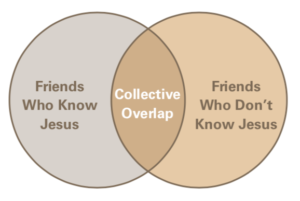
How to Separate Critical and Creative Thinking
Does your team have agreement around vision, but lack ownership and alignment?
Effective teams do not just agree on vision, they own it and align every ounce of energy and effort toward accomplishing the vision. As a leader, you can sense the difference between your team liking the vision and your team leading toward vision.
In most instances, simple agreement feels like an invisible wall sits somewhere within the team. A divide of mistrust, misunderstanding, or missed input often exists in the origination of the vision. This always leads to misalignment and missed opportunity in the execution of vision.
Every busy week brings a fresh truckload of glass bricks for your team to stack on this invisible wall. No one has ill motives. No one intends cement separation, but the walls go up without conscious notice as the pace of ministry continues.
The good news is that it’s NOT rocket science to take down a wall. Haven’t you noticed it’s easier (and usually more fun) to demolish than it is to build? What your team needs are sledgehammers to take down these hard-to-see barriers.
How do you tear down your team’s invisible walls?
Separate Critical and Creative Thinking
THE QUICK SUMMARY – Hatch! by C. Wilson McNair
Most Corporate Brainstorming Isn’t Brainstorming… not even close. (Usually what’s going on is playful arguing with snacks on the table.)
McNair Wilson spent a decade inside Disney – mostly at Disney Imagineering designing theme parks. His teams hatched so many ideas he was invited to teach his methods through Disney University. His “7 Agreements of Brainstorming” will assist your team in launching world-class products, services, and programs. You will create competition-crushing concepts using brainstorming that works! (And you can keep the snacks on the table.)
Whatever’s next for your organization, why not make it best? HATCH! is a highly entertaining book filled with the author’s witty drawings and scores of examples of McNair’s 7 Agreements in use by big corporations and small non-profits.
A SIMPLE SOLUTION
The problem with brainstorming is that everyone thinks they already do it.
The reality is that nobody knows how to brainstorm anymore. It’s not your colleagues’ fault – or yours. Nobody knows how to brainstorm anymore because it is likely every model we have seen contains significant roadblocks to actual innovation.
Far too often, the “way you’ve always done it” is the wrong way – the least productive and the most frustrating.
According to former Disney Imagineer C. McNair Wilson, real brainstorming is both fun to do and very productive- all at the same time.
Done right, brainstorming produces amazing results because “we are smarter than me.”
Start your brainstorming by separating Creative Thinking and Critical Thinking.
Both must be done, but they must be done separately if anything of lasting value will be accomplished.
Creative thinking is idea generating, imagining, wondering out loud, dreaming, “what-iffing.” The decidedly different activity of Critical Thinking is not so much thinking negatively as it is thinking with analysis, focus, intentionality, and purpose.
You will have made huge strides toward powerful Creative Thinking once your team embraces and agrees to this important distinction: Creative and Critical Thinking are not part of the same activity and do not, cannot, must not occur simultaneously. It doesn’t work. They cannot occupy the same space. They are the beginning and end of the process whether it is five minutes or five months. Folding them together means doing neither activity effectively. And it is not brainstorming.
You cannot be fully, actively, creative if you are simultaneously thinking critically.
It is vital that you learn to postpone judgment, evaluation, and analysis until you and your team get everything out of your head and up on the wall. You are hatching a plan. Every chicken, eventually, leaves the egg. During Creative Thinking you are offering thought fragments, whims, notions, doodles, bits, and pieces.
The key to Creative Thinking is to learn not to care. That is to say, get to a point where you learn not to care of your ideas make sense, are possible, or if they fit into the project budget. You will care about all that later. This is true for all the ideas that flash through your mind during Creative Thinking.
Don’t deliberate, divulge.
Don’t analyze, add.
Don’t decide, confide.
Don’t edit, say it.
You cannot possibly know when a tiny, fleeting thought will be just the spark to ignite a bonfire of creativity in other team members.
C. Wilson McNair, Hatch
A NEXT STEP
Auxano developed a team collaboration tool that we use with every church team. The Collaboration Cube specifically addresses this need for separation between creative and critical thinking.
The Cube is built around the three modes of good collaboration: Blue Sky, Discuss/Challenge, and Decide/ Commit. Each mode represents the ground rules for how the team is interacting at any given time. A facilitator, team leader, or team member can use the Cube to signal a shift or recommend a change of the team’s mode.
Blue Sky mode is the classic brainstorming time where it is critical to generate a great volume of ideas while delaying judgment or critique. The basic principle of creativity is that great ideas are generated through many ideas. While many teams are familiar with the general idea of brainstorming, few practice it, because of the discipline required to suspend judgment, or Critical Thinking. Use the Cube to strengthen this mode of Creative Thinking.
Discuss/Challenge is the default mode where four Critical Thinking roles are put into play and where feedback and pushback are openly discussed. Discuss/ Challenge is the dominant mode that occurs during collaboration. Remember, each role is a default style that each team member tends to play, but during collaboration, each person can pass in and out of each role as collaboration progresses to Decide/Commit.
Decide/Commit is the mode signaled by the facilitator when moving toward a consensus decision or clarifying final action steps. In this mode a leader is able to “land the plane” on the meeting or session. This is the time when the facilitator or leader senses that enough dialogue and “ah-ha moments” have occurred to move toward a meaningful conclusion. When it comes time to Decide/Commit and you poll your team, use this definition of consensus: “Consensus is not when 80% of people feel 100% good about an idea; consensus is when 100% of the team feels 80% good about an idea.”
Visit collaborationcube.com to learn more and to purchase Cubes for your team.
Excerpt taken from SUMS Remix 50-3.
This is part of a weekly series posting excerpts from one of the most innovative content sources in the church world: SUMS Remix book excerpts for church leaders.
SUMS Remix takes a practical problem in the church and looks at it with three solutions; each solution is taken from a different book. Additionally, a practical action step is included with each solution.
As a church leader you get to scan relevant books based on practical tools and solutions to real ministry problems, not just by the cover of the book. Each post will have the edition number which shows the year and what number it is in the overall sequence. (SUMS Remix provides 26 issues per year, delivered every other week to your inbox).
>> Subscribe to SUMS Remix <<

Tags: C. Wilson McNair, Hatch!, SUMS Remix, Team Brainstorm, Vision, brainstorming



























